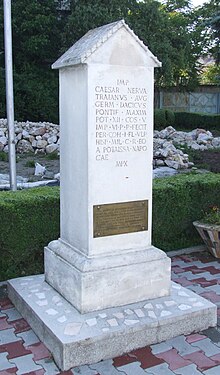Milliarium of Aiton
You can help expand this article with text translated from the corresponding article in Romanian. (February 2011) Click [show] for important translation instructions.
|

Milliarium of Aiton is an ancient Roman milliarium (milestone) discovered in the 1758 in Aiton commune, near Cluj-Napoca, Romania.[1] Dating from 108 AD, shortly after the Roman conquest of Dacia, the milestone shows the construction of the road from Potaissa to Napoca, by demand of the Emperor Trajan. It indicates the distance of ten thousand feet (P.M.X.) to Potaissa. This is the first epigraphical attestation of the settlements of Potaissa and Napoca in Roman Dacia.
Background
[edit]The complete inscription is: "Imp(erator)/ Caesar Nerva/ Traianus Aug(ustus)/ Germ(anicus) Dacicus/ pontif(ex) maxim(us)/ (sic) pot(estate) XII co(n)s(ul) V/ imp(erator) VI p(ater) p(atriae) fecit/ per coh(ortem) I Fl(aviam) Vlp(iam)/ Hisp(anam) mil(liariam) c(ivium) R(omanorum) eq(uitatam)/ a Potaissa Napo/cam / m(ilia) p(assuum) X". It was recorded in the Corpus Inscriptionum Latinarum, vol. III, the 1627, Berlin, 1863.
This milliarium is an attestation of the road known to be built by Cohors I Hispanorum miliaria.[2]
A copy of this milliarium was erected in June 1993 in front of the Turda Post Office (1 Dec. 1918 Street). Another copy exists in the front of the Aiton School.
Gallery
[edit]-
Modern plaque from the monument in Turda
-
Latin inscription from the milliarium
-
1758 Drawing of the original milliarium
See also
[edit]Notes
[edit]References
[edit]- Constantin Daicoviciu, Un nou miliarium din Dacia, in AISC, I, 2, 1928-1932, p. 51.
- Florin-Gheorghe Fodorean - Izvoare epigrafice privind drumurile in Dacia romană
- Florin-Gheorghe Fodorean – „A POTAISSA NAPOCAE MP X. TRAJAN’S IMPERIAL ROAD AND THEMANSIO FROM AITON (CLUJ COUNTY)“ Archived 2018-07-22 at the Wayback Machine
Further reading
[edit]External links
[edit]

